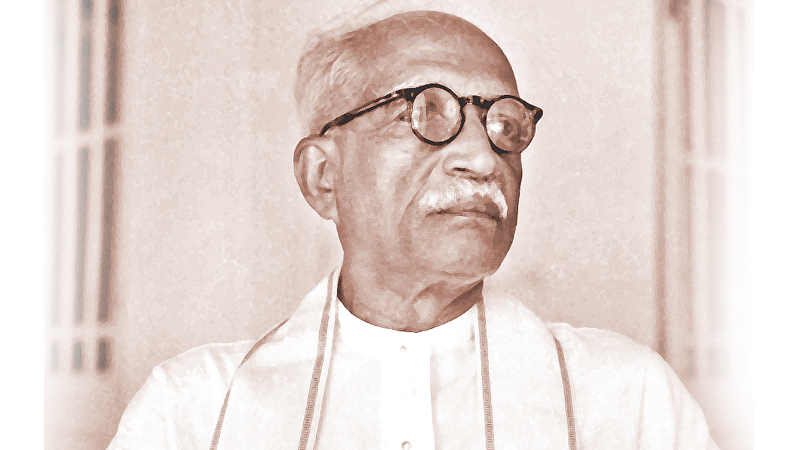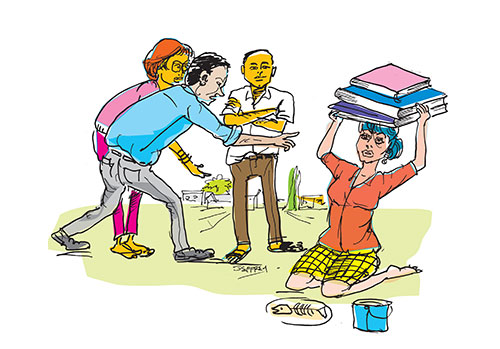By Ramya Kumar
This week’s Kuppi Talk takes off from an earlier piece on ragging that drew attention to the anti-democratic culture that breeds violence within the university system. Shamala Kumar linked this violence to the lack of democracy within universities, and society more broadly.
When we talk about violence within our universities, the conversation invariably turns to ragging. Some of us also talk about other forms of violence, such as the arbitrary sacking of a vice chancellor or an academic who does not toe the line. But the classed, gendered, and ethnicized forms of everyday violence we experience within the university system remain invisible. Here, I draw on discussions with students and teachers at various state universities to illustrate how gender violence pervades our everyday, and perpetuates exclusion and injustice.
Hierarchical systems
Our education system, whether primary, secondary, or tertiary, coaches students to conform and to not question authority. Non-conformers are penalized, and alternative ways of thinking discouraged within an exam-oriented system that measures performance by grades. On top of that, school curricula reinforce social hierarchies and difference by using myths or tropes like the ancient Sinhala king, the sari-clad virtuous mother, or the meat-loving Muslim.
When they enter the university, students are already saddled with various stereotypes and prejudice conveyed as authoritative knowledge through this system. Many would not have interacted with people outside their frame of thinking/knowing. Ignorance, misinformation (conveyed through the ragging apparatus) and the unfamiliar environment of the university creates conditions for further polarization. An undergraduate talked about the oppressive environment she encountered in her first week at university:
“The seniors harassed the boys [in our batch] if we did something “wrong” like dress “indecently” or behave “incorrectly.” The male seniors had discussions with our boys about how we dress and what was wrong with us….[they were told] the girls were their responsibility… “See, we have our girls in the palm of our hands, they listen to everything we say, yours also should be like that” they said. So ultimately the way we dressed, where and when we went out, and everything we did were to be dictated by a group of boys who were our age, who were strangers … we knew better, but it was very stressful and confusing.”
University authorities have not been able to address ragging because the university itself is built on systems of hierarchy. In fact, our universities are complicit in such acts of violence. For instance, a Muslim undergraduate who wears hijab talked about feeling marginalized after the Easter Sunday bombings when security personnel singled her out to check her backpack, commenting that she looked like “Zahran’s sister,” while letting others pass through.
From second class students…
Students internalize gender and other “norms” with few opportunities or forums to question them. Their activities are often divided along gender lines, albeit varying in different settings. When organizing an event, women tend to take on clerical and accounts work and tasks like serving tea. In some faculties, women attend lectures, dutifully taking notes for men, who are coerced into less mundane engagements by unions (and others) during lectures. Those who fail to conform to this “subculture” are branded as selfish, anti-social, or elitist.
At many universities, women (students) are not considered for leadership positions, such as president of a student union or association, even in faculties where women far outnumber men. “The mental picture of a leader is always male…it is the norm,” said an undergraduate. This “norm” is often justified on the grounds that women cannot travel back home/to their hostels after meetings, a strange notion for the many women who travel on their own. Most elections do not involve voting as decisions are made “unanimously” before elections. When women find themselves in leadership roles, they are often spoken over and not heard.
Women’s attire is strictly under surveillance. A Muslim undergraduate spoke of being banned from the prayer room at her faculty because her skirt did not reach her toes. A Tamil undergraduate who studied in the south described how her (Tamil) friends in another faculty had to wear Salwar, a single plait, pottu and vibhuti to maintain their “culture” in the dominant (Sinhala) environment. Similarly, women Sinhala students in the North are warned by their male counterparts not to transgress so-called Tamil norms by wearing short skirts, or tight clothes, in the name of safety and security.
Gender norms are also reinforced by university teachers and others in positions of authority. A medical undergraduate felt discouraged when a clinician advised the women in her group to think carefully before embarking on postgraduate studies: “[The doctor] said we would get late to marry, that we may not find a husband, and that our studies would interfere with our duties as a wife and mother.” Another student spoke of a clinician who referred to female students, including herself, by body shape and size, making her feel humiliated. Women encounter these forms of violence on a daily basis, making them feel little and unimportant, even as some confront the system head on, struggling to redraw boundaries and trouble the status quo.
… to second class academics
The university hierarchy places temporary and probationary lecturers at the very bottom. A professor described the ways in which younger lecturers, especially women, are silenced at meetings in her Faculty: “They are just not taken seriously … their contributions are ignored or they are simply spoken over.” A temporary lecturer talked about being harassed by a member of the support staff when she commenced work. He was known for treating women disrespectfully, but her complaints fell on deaf ears. A system that favours internal recruitment sustains hierarchy, obliging junior staff to take on additional (uncredited) work and even forego first authorship in publication, to support their seniors in the race to professorship.
As academics, women are frequently excluded from decision-making processes, which usually take place at informal meetings among an “in group” of (predominantly) men, who flock around (and bow down to) the administration. This culture of decision-making prevails at all levels of the university, and, by virtue of its character, excludes women and minorities, who cannot participate in the “machan” talk and camaraderie, for different reasons. Those who speak up or ask questions are delegitimized as fussy, irrational, or troublemakers. “Men throwing a tantrum is totally acceptable, but when a woman does that, she is being emotional,” a senior lecture pointed out. A professor spoke of feeling stifled during Senate meetings where questions and discussion were generally discouraged: “When I pointed to a breach in procedure, the VC asked me to stop raising trivial issues.”
The gender hierarchy is more visible at higher echelons of the university. The UGC and university councils are dominated by men. Although women do hold positions of authority within universities, as deans and, less frequently, vice chancellors, the gendering of academic work continues. In various committees, women tend to take on a lot of coordinating and paperwork, but their contributions remain uncredited as they rarely share the limelight. In fact, many women are faulted for their “family commitments,” and any negative traits attributed to their gender. Yet, the (widespread) mediocrity of men is never attributed to gender.
At the root of all this is pervasive sexism that objectifies and sexualizes women. It is commonplace for women academics to receive comments on their hair do or attire. A professor commented, “There is no understanding of what is appropriate here.” Even when there are serious breaches of conduct, like sexual harassment, there is nowhere to go. “Using established university procedures to address sexual harassment comes with risks that most women are not willing to take,” she continued. Overall, there seems to be very little trust in the system, and, in all likelihood, any incidents, along with their inquiry reports, may be brushed under the carpet.
Consequences
What does this situation ultimately mean for universities and society? Most immediately, it allows university administrators to function in the service of power. Second, rather than pushing the boundaries of knowledge and public discourse, central to their role, our universities reinforce social hierarchies, with accompanying exclusions and marginalisations. Third, by discouraging critical dialogue, the system sustains a disengaged university community that remains paralysed in the face of injustice, and supports producing graduates who easily comply with authority. The consequences are far-reaching, as we see in the unfolding COVID-19 mess.
Clearing up this mess must start from within our institutions. Building on the egalitarian principle of Free Education, we need to create inclusive spaces for students and teachers to come together to dialogue on the trajectory of higher education, and demand justice at this critical juncture.



